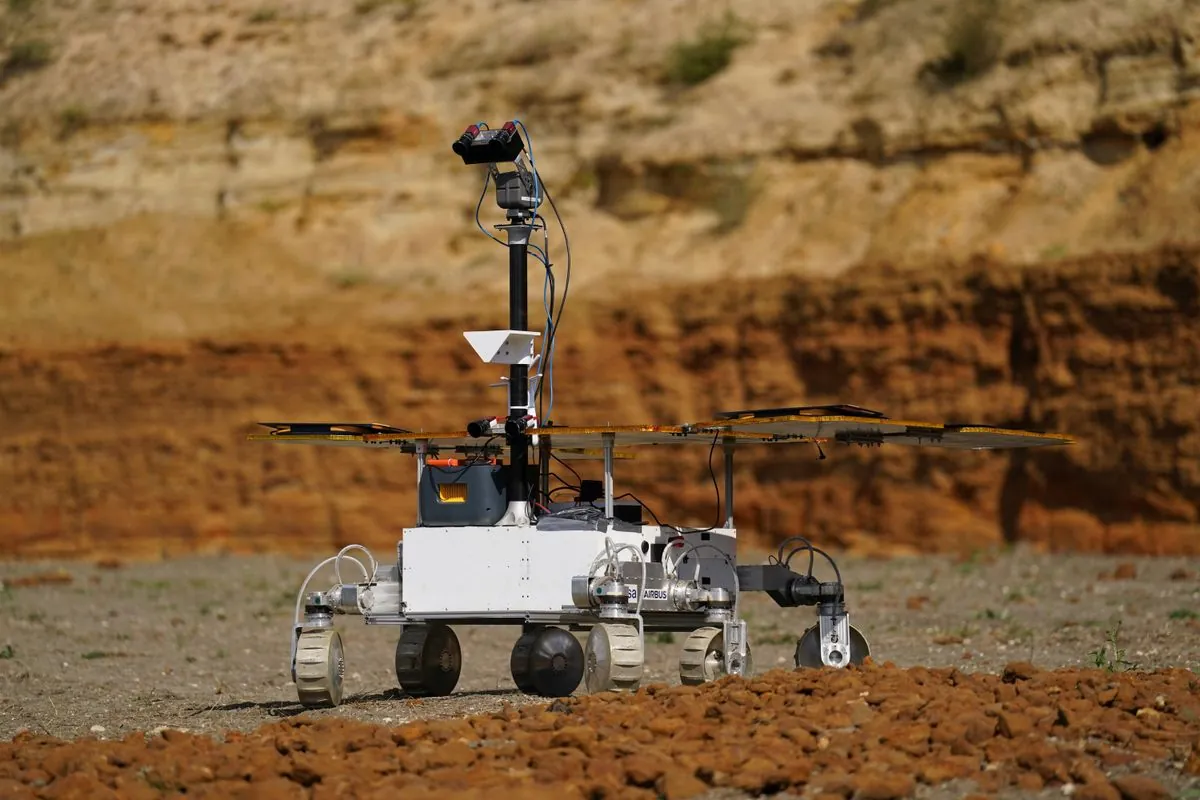
In a Bedfordshire quarry, a scene reminiscent of the Martian landscape unfolds as the ExoMars Rosalind Franklin rover navigates a rocky, red-hued terrain. This British-built robot, set to launch in 2028, is undergoing crucial tests on simulated Martian terrain, preparing for its mission to potentially uncover evidence of extraterrestrial life.
The European Space Agency (ESA) leads this groundbreaking mission, which aims to be the first to drill two meters into the Martian surface. At this depth, beyond the reach of space radiation, the rover may discover fossilized microbes, potentially proving that life evolved beyond Earth. This mission is particularly significant as Mars, despite its current harsh conditions, shares similarities with Earth, including a 24-hour and 37-minute day and seasons caused by its axial tilt.
Chris Draper, exploration rovers programme manager at Airbus, expressed optimism about the mission's potential: "ExoMars is unique in its ability to obtain subsurface samples and analyze them for signs of past or present life." The rover's capabilities are crucial, given that Mars' thin atmosphere offers little protection against ultraviolet radiation, making surface life unlikely.
Over the past three weeks, engineers have been testing the rover's autonomous navigation systems. Nicknamed Charlie, the six-wheeled test rover has been maneuvering through a sand quarry near Leighton Buzzard, the same location where scenes from "Mission: Impossible – Dead Reckoning" were filmed. This testing is essential to ensure the rover can navigate independently, map terrain, and avoid obstacles on the Red Planet, where the average temperature is a frigid -63°C.

The ExoMars mission has faced challenges, including the severance of ties with the Russian space agency Roscosmos following the Ukraine conflict. In response, the UK Space Agency provided £10.7 million to replace a crucial Russian instrument for identifying promising life-detection sites.
The mission delay has allowed for improvements in the rover's navigation capabilities and the testing of new Lidar sensors, which could prove valuable in Mars' dust storm-prone environment. These enhancements are critical, as the communication delay between Earth and Mars can range from 4 to 21 minutes, necessitating the rover's autonomous operation.
Engineers are also testing the Sample Fetch rover, nicknamed Codi, which features a robotic arm capable of autonomously locating and collecting sample tubes using advanced AI algorithms. Originally designed for NASA and ESA's Mars Sample Return mission, Codi may now serve as a backup option or be repurposed for lunar missions.
Chris Barclay, Airbus's guidance navigation and control architect, highlighted the potential versatility of the technology: "It could be used for exploration of other celestial bodies or asteroids. The ability to retrieve targeted objects autonomously is invaluable for future missions."
As the ExoMars rover continues its preparations, it carries the hopes of scientists and space enthusiasts alike. Its mission to drill into the Martian surface, where water ice has been detected, could unlock secrets about the planet's past and potentially reshape our understanding of life in the universe.
"It all has to be done remotely, because obviously you can't just use a joystick and drive it. It has to be smart and do things by itself."
This ambitious project not only pushes the boundaries of space exploration but also showcases the ingenuity and collaboration of international space agencies and private companies in the quest to unravel the mysteries of our celestial neighbor.
British-built ExoMars rover undergoes testing in UK quarry, preparing for 2028 Mars mission. The rover aims to drill deep into Martian soil, searching for signs of ancient microbial life.